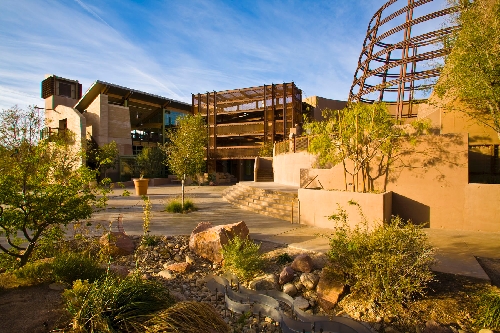Color will pop during Springs Preserve tour
There seems to be a common thread developing with these monthly plant tours and sales at the Springs Preserve and it's color. Preserve workers attempted to satisfy this craving as they selected plants for each month's tour. Those attending the latest program will see five mature plants in their peak of beauty. These plants will be available after the tour. Give them a little TLC and let the flower show begin.
The tour will be at 10 a.m. Thursday at the Springs Preserve, 333 S. Valley View Blvd., at the Dr. Green Thumb booth. Landscapers are using these natives in their designs and winning awards from the Southern Nevada Water Authority. Here are the plants that will be on display:
n Diamond cholla (Cylindropuntia ramosissima) is a knee-high shrub dressing itself with yellow- to apricot-colored flowers in the summer. It works well in traditional cactus gardens, containers or used as a foundation plant for hot spots.
n Banana yucca (Yucca bacata) gets waist high with blue-green two-feet-long leaves. Rising two feet above those leaves are finger-long creamy flowers. It is an excellent minimal care plant mixed among rocks and cactuses for a native look or with shrubs to show off its blue stiff leaves.
n Desert saltbush (Atriplex polycarpa) gets waist high in a natural rounded shape. It makes an outstanding foundation plant or a nice casual hedge, using its silvery lacy nature to contrast with other plants.
n Purple three-awn (Aristida purpurea) is a clump grass that gets knee high. Seeds develop awns to catch sunlight, creating an attractive silhouette. Use this plant as an accent in cactus gardens, near boulders or mixed in with perennials.
n Murphey agave (Agave murpheyi) gets waist high and freely produces small colonies of pups as it ages. The one-time bloomer becomes a showstopper because it is so dramatic. Use it as an accent plant mixed in with cactuses, rocks or perennials to make an excellent contrasting plant.
Here are some questions I encountered this past week:
Q: Why won't grass grow where I ground up a tree stump?
A: After removing the stump, microorganisms went to work decomposing the wood chips and sawdust. They robbed all the nitrogen to do this, so other plants can't survive. Decomposition will take months to complete. Add a light application of nitrogen to speed up the process.
Q: How do I start palo verde plants from seed?
A: Remove seeds from pods now falling from trees. Nick the hard seed coat with a knife or awl and soak the seeds in water for 24 hours. Plant them in a good-draining potting mix and keep them moist and out of full sun until they root. Plant the seedlings in desired locations in the fall.
Q: What can I do to discourage leafcutter bees from carving circles out of my rose leaves? They've denuded one rose.
A: Since cutter bees do not ingest rose leaves, there is little we can do to stop them unless you stand guard with a can of bug spray and douse bees while carving out their circles. You are right. Once they focus on a plant, they really work it over.
Leafcutter bees are beneficial pollinators, and we don't want to eliminate them. I've seen only one leafcutter bee take a leaf and it happened so quickly. Look on the damage as sculpturing with pinking shears.
Q: You mentioned buffalo grass before. Does blue grama grass grow here?
A: Yes! The Springs Preserve has a beautiful patch in its garden. Here are its characteristics: It is drought- and heat-tolerant, doesn't involve much maintenance or mowing, will tolerate foot traffic, greens up earlier and stays green longer than buffalo grass, is easy to start from seeds, spreads by rhizomes and its seed heads look like eyelashes. You can get seeds from highcountrygardens.com
Q: Can we grow potatoes here?
A: Yes, but plant them early next spring. Place potato starts in a highly organic soil and cover the ground with straw. Your potatoes will develop in the straw, making it easy to harvest them.
Q: Why was my lettuce sweet and then turned bitter?
A: We had a cool spring to explain the sweetness. Then it turned hot and the lettuce turned bitter. The lettuce also may have run shy of nitrogen and water, which also can cause bitterness. Plant your lettuce in September and next February.
Linn Mills writes a garden column each Sunday. You can reach him at linn.mills@ springspreserve.org or call him at 822-7754.

















